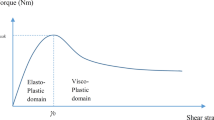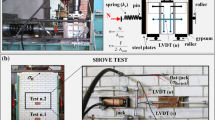Abstract
Recent developments in understanding the rheology of mortar and concrete as well as applying this understanding in the practice of construction necessitate an accurate assessment of materials’ rheological properties. It is well known that different rheometers for mortar and concrete deliver different results, as this was shown over 15 years ago in two measuring campaigns comparing concrete rheometers. Considering newly developed rheometers, including those to evaluate interface rheology and structural build-up at rest, as well as additional measurement procedures and data interpretation techniques, a new comparison campaign was carried out in 2018 at the Université d’Artois, in Bethune, France. This new campaign focused on measuring workability characteristics, flow curves, static yield stress values, interface properties and tribological data. A total of 14 different devices capable of measuring one or more of the above-mentioned characteristics were employed. These devices included four ICAR rheometers, the Viskomat XL, the eBT-V, the RheoCAD (two geometries), the 4SCC rheometer (two geometries), the plate test, the sliding pipe rheometer, a tribometer and an interface tool for the ICAR rheometer. This paper describes the mixture design and rationale of the five investigated concrete and three investigated mortar mixtures, design and analysis of the experiments, and comparison of test results. The findings confirmed some of the conclusions from two previous testing campaigns and expanded the findings to more modern concrete mixtures and more diversified sets of rheological devices. The investigated rheometers yielded different absolute values for material parameters, but they all were able to similarly distinguish between mixtures qualitatively. For static yield stress and interface rheology measurements, similar conclusions were obtained as for flow curves.







Similar content being viewed by others
References
Tattersall G, Banfill P (1983) The rheology of fresh concrete. Pitman, London
Ovarlez G (2012) Introduction of the rheometry of complex suspensions. In: Roussel N (ed) Understanding the rheology of concrete. Woodhead Publishing Limited, Cambridge, pp 23–62
Mechtcherine V, Gram A, Krenzer K, Schwabe J-H, Shyshko S, Roussel N (2014) Simulation of fresh concrete flow using discrete element method (DEM): theory and applications. Mater Struct 47:615–630
Roussel N, Geiker M, Dufour F, Thrane L, Szabo P (2007) Computational modeling of concrete flow: general overview. Cem Concr Res 37(9):1298–1307
Wallevik J (2003) Rheology of particle suspensions: fresh concrete, mortar and cement paste with various types of lignosulfonates. PhD dissertation, The Norwegian University of Science and Technology (NTNU)
Vasilic K, Gram A, Wallevik JE (2019) Numerical simulation of fresh concrete flow: insight and challenges. RILEM Tech Lett 4:57–66
Wallevik JE, Wallevik OH (2017) Analysis of shear rate inside a concrete truck mixer. Cem Concr Res 95:9–17
Wallevik O, Feys D, Wallevik J, Khayat K (2015) Avoiding inaccurate interpretations of rheological measurements for cement-based materials. Cem Concr Res 78:100–109
Banfill P, Beaupré D, Chapdelaine F, de Larrard F, Domone P, Nachbaur L, Sedran T, Wallevik O, Wallevik JE (2000) Comparison of concrete rheometers: international tests at LCPC, Nantes. NISTIR 6819
Ferraris CF, Brower LE, Beaupré D, Chapdelaine F, Struble L, Domone P, Koehler E, Lin S, Sonebi M, Struble L, Tepke D, Wallevik O, Wallevik JE (2003) Comparison of concrete rheometers: international tests at MB, Cleveland OH, USA. NISTIR 7154
Haist M, Link J, Nicia D, Leinitz S, Baumert C, von Bronk T, Cotardo D, Eslami Pirharati M, Fataei S, Garrecht H, Gehlen C, Hauschildt I, Ivanova I, Jesinghausen S, Klein C, Krauss H-W, Lohaus L, Lowke D, Mazanec O, Pawelczyk S, Pott U, Radebe NW, Riedmiller JJ, Schmid H-J, Schmidt W, Secrieru E, Stephan D, Thiedeitz M, Wilhelm M, Mechtcherine V (2020) Interlaboratory study on rheological properties of cement pastes and reference substances: comparability of measurements performed with different rheometers and measurement geometries. Mater Struct 53:92
Ferraris CF, Martys NS (2012) Concrete rheometers. In: Roussel N (ed) Understanding rheology concrete, 1st edn. Woodhead Publishing Limited, pp 63–82
Greim M (2019) Rheometers for paste, mortar and concrete: measurement technology—possibilities, challenges and limits, in one-day feedback—round robin test: comparison of concrete rheometers: international tests at the Artois University, Paris
Macosko C (1994) Rheology, principles, measurements, and applications, Poughkeepsie. Wiley, New Jersey
Coussot P (2005) Rheometry of pastes, suspensions, and granular materials. Application in industry and environment. Wiley, New Jersey
Ferraris C (1999) Measurement of the rheological properties of cement paste: a new approach, In: International RILEM Conference on the Role of Admixtures in High Performance Concrete
Hafid H, Ovarlez G, Toussaint F, Jezequel P, Roussel N (2015) Assessment of potential concrete and mortar rheometry artifacts using magnetic resonance imaging. Cem Concr Res 71:29–35
Spangenberg J, Roussel N, Hattel J, Sarmiento E, Zirgulis G, Geiker M (2012) Patterns of gravity induced aggregate migration during casting of fluid concretes. Cem Concr Res 42(12):1571–1578
Feys D, Khayat K (2017) Particle migration during concrete rheometry: how bad is it? Mater Struct 50(2):122
Zhu H, Martys N, Ferraris C, De Kee D (2010) A numerical study of the flow of Bingham-like fluids in two-dimensional vane and cylinder rheometers using a smoothed particle hydrodynamics (SPH) based method. J Non-Newton Fluid Mech 165(7–8):362–375
Wallevik J (2014) Effect of the hydrodynamic pressure on shaft torque for a 4-blades vane rheometer. Int J Heat Fluid Flow 50:95–102
Wallevik J (2008) Minimizing end-effects in the coaxial cylinders viscometer: viscoplastic flow inside the ConTec BML viscometer 3. J Non-Newton Fluid Mech 155(3):116–123
Billberg P, Roussel N, Amziane S, Beitzel M, Charitou G, Freund B, Gardner J, Grampeix G, Graubner C, Keller L, Khayat K (2014) Field validation of models for predicting lateral form pressure exerted by SCC. Cem Concr Compos 54:70–79
Roussel N, Cussigh F (2008) Distinct-layer casting of SCC: the mechanical consequences of thixotropy. Cem Concr Res 38(5):624–632
Perrot A, Rangeard D, Pierre A (2016) Structural built-up of cement-based materials used for 3D-printing extrusion techniques. Mater Struct 49(4):1213–1220
Roussel N (2018) Rheological requirements for printable concretes. Cem Concr Res 112:76–85
Mechtcherine V, Nerella V, Kasten K (2014) Testing pumpability of concrete using sliding pipe rheometer. Constr Build Mater 53:312–323
Kaplan D (2000) Pumping of concrete. PhD dissertation, École des Ponts ParisTech (in French)
Feys D, Khayat K, Perez-Schell A, Khatib R (2014) Development of a tribometer to characterize lubrication layer properties of self-consolidating concrete. Cem Concr Compos 54:40–52
Kasten K (2010) Gleitrohr-Rheometer—Ein Verfahren zur Bestimmung der Fließeigenschaften von Dickstoffen in Rohrleitungen. PhD dissertation, Technische Universität Dresden (in German)
Djelal C, Vanhove Y, Magnin A (2004) Tribological behaviour of self compacting concrete. Cem Concr Res 34(5):821–828
Vanhove Y, Djelal C, Magnin A (2004) Prediction of the lateral pressure exerted by self-compacting concrete on formwork. Mag Concr Res 56(1):55–62
Roussel N (2006) A thixotropy model for fresh fluid concretes: theory, validation and applications. Cem Concr Res 36(10):1797–1806
Amziane S, Perrot A (2017) The plate test carried out on fresh cement-based materials: how and why? Cem Concr Res 93:1–7
Zhang M, Ferraris C, Zhu H, Picandet V, Peltz M, Stutzman P, De Kee D (2010) Measurement of yield stress for concentrated suspensions using a plate device. Mater Struct 43(1):47–62
Amziane S, Perrot A, Lecompte T (2008) A novel settling and structural build-up measurement method. Meas Sci Technol 19(10):105702
Acknowledgements
The authors would like to acknowledge EQIOM Concrete for the donation, delivery and adjustment of the investigated mixtures. The technical support of the mix design team of EQIOM Concrete in changing the rheological properties of the mixtures to suit the testing program is greatly appreciated. The authors wish to express their gratitude and sincere appreciation to the French Group of Rheology (GFR), the agglomeration community Artois Com, the French National Federation of Public Works (FNTP), the Structure&Réhabilitation company, The Université d’Artois and the Laboratoire de Génie Civil et géo-Environnement (LGCgE) for giving financial support to perform this study. The authors acknowledge the support of the Civil Engineering Department of the Université d’Artois for making their facilities available to the research team, as well as Francis Thibaut (technical staff), Sacha Crepelle, Apolline Dilly, Agnaou Elhachemi, Salim Hammoumi, Issam Laiymani and Edouard Morel (students) for their help during three intensive days of testing.
Author information
Authors and Affiliations
Corresponding author
Ethics declarations
Conflict of interest
None of the authors declare a conflict of interest.
Additional information
Publisher's Note
Springer Nature remains neutral with regard to jurisdictional claims in published maps and institutional affiliations.
This document is the result of an experimental campaign supported by and carried out by a taskgroup of RILEM TC 266-MRP. All members of the taskgroup are listed as authors for this paper, except for Faber Fabbris from EQIOM concrete. The following individuals are the members of RILEM TC 266-MRP who were not involved in the taskgroup: Rolands Cepuritis, Geert De Schutter, Siamak Fakhraei, Steffen Grunewald, Michael Haist, Stefan Jacobsen, Karel Lesage, Julian Link, Dirk Lowke, Tilo Proske, Nicolas Roussel, Wolfram Schmidt, Jon E. Wallevik, Ammar Yahia, and Jiang Zhu. This paper was reviewed and approved by all members of the committee.
Rights and permissions
Springer Nature or its licensor (e.g. a society or other partner) holds exclusive rights to this article under a publishing agreement with the author(s) or other rightsholder(s); author self-archiving of the accepted manuscript version of this article is solely governed by the terms of such publishing agreement and applicable law.
About this article
Cite this article
Feys, D., Sonebi, M., Amziane, S. et al. RILEM TC 266-MRP: round-robin rheological tests on high performance mortar and concrete with adapted rheology—rheometers, mixtures and procedures. Mater Struct 56, 90 (2023). https://doi.org/10.1617/s11527-023-02173-1
Received:
Accepted:
Published:
DOI: https://doi.org/10.1617/s11527-023-02173-1




